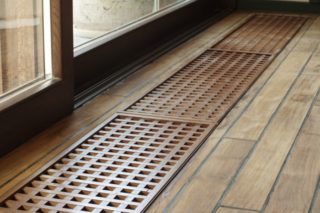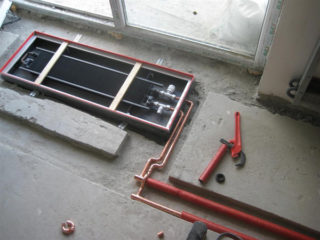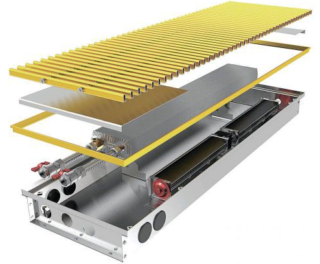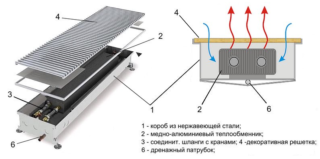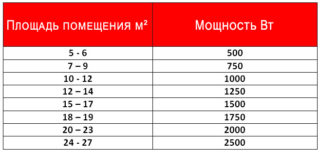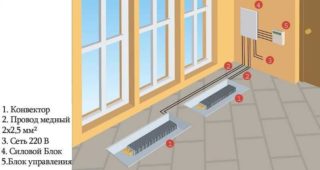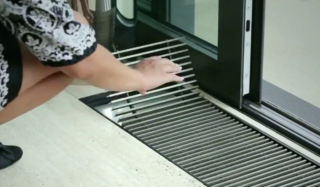New design technologies in the construction of houses have led to the need to create new ways of heating systems. One of the most attractive and sought-after solutions is panoramic glazing. But in such a situation, the problem of lack of space for the location of radiators arises. An excellent solution is the installation of floor heating convectors.
Device and principle of operation
Underfloor heating radiators are a great alternative to traditional heating devices. Due to the special design, heat is transferred with maximum efficiency by convection. The principle of operation of the device is the passage of cold air around the heat exchanger. Air temperature rises, therefore, its density decreases. Due to this, warm air rises and enters the room through a decorative grill.
The device itself is a stainless steel case. The metal must meet high corrosion resistance.
Types and characteristics
Convectors can be built into the floor or mounted on top. Depending on the heat source, water and electrical appliances are released.
Water
The water-type device is a galvanized steel box in which a heat exchanger is placed in the form of a U-shaped pipe. The radiator is built into the channel, which is previously done in the rough floor. From above it is covered with a decorative lattice.
Air heats up and rises, replacing cold masses. Media temperature rises to 900 degrees. The heating power can be adjusted using the built-in fan. Thanks to temperature sensors, the fan automatically shuts off or the speed changes.
Since the body of the water radiator is built into the floor, there are no special requirements for its design. Particular attention should be paid to the quality of the metal. If there is increased humidity in the room, the case must be stainless steel. For dry rooms, galvanized steel is acceptable.
Floor-mounted convectors for water heating are not installed in apartments, since they are forbidden to be connected to the central system.
Heaters are used in the following cases:
- in public premises of institutions, private houses;
- in places where it is not possible to install radiators.
It is also a good option for organizing heating in the pools.
Electric
Electroconvectors can work without installing fans. They are equipped with special ventilation elements. Models with fans are installed in rooms in which there is much more heat consumption.
Electric floor convectors have the following advantages:
- compact sizes;
- reliable steel case;
- silent work;
- economical energy consumption.
The principle of operation is based on thermal convection. The disadvantages of such a system include the inability to install in rooms with a high level of humidity.
Advantages and disadvantages of equipment
Underfloor heating has its pros and cons in the installation. The positive aspects include:
- Absolute safety when using. Such equipment can be installed in children's rooms.All heating elements are under the grill.
- Compact size - the radiator will not take up much space against the wall.
- Durability - these batteries are reliable and strong. Since they are hidden from external influences, they are not in danger of damage.
- Compared to traditional radiators, underfloor heating a room is much faster. They also more effectively maintain the temperature in the room.
Before choosing a radiator, you need to evaluate the disadvantages of floor convectors. Their installation increases the thickness of the floor - the required minimum level should be 15 cm. If the room has low ceilings, this solution will not work. In addition, the system has a complex installation.
Primary requirements
To make the right choice, you need to know about all the features of the device.
The convector body must be made of metal. It is an elongated tray, which is painted with anti-corrosion protection.
A decorative grille is the only noticeable element of the entire convector. But when choosing a device, not only aesthetic appeal is important. A significant selection criterion is the distance between the slats.
Large cracks can dust and small objects. Therefore, you need to watch so that little children do not put their fingers there. The grille will be part of the interior design, so you need to select it in accordance with these conditions.
It is important when selecting the following characteristics;
- Colour;
- metal of manufacture (steel or aluminum);
- shape and size of lamellas, their location.
Roll lattices look more elegant, monolithic most often choose modern and high-tech for the style.
Rules for choosing floor convectors
Before you purchase equipment, it is recommended that you read the rating and reviews. A large selection of Russian and European manufacturers is presented on the market. The most popular are Kermi floor convectors. These are German systems characterized by reliability and quality. All equipment is adapted for Russian heating systems.
When choosing, it is recommended to focus on the following points:
- equipment power - should be calculated based on 100 W per 1 square meter;
- heat transfer parameters should be indicated no more than 70 degrees;
- Recommended convector depth should be 90 cm.
It is better to purchase domestic equipment for natural convection, and foreign for forced convection.
Installation and Connection
Most often, the connection of floor convectors is necessary in rooms where there is too much heat loss. To correctly install, you must adhere to the recommendations:
- a niche should be made at least 1 cm higher from the entire height of the device;
- indentation from the wall is done at a distance of 15-30 cm, from the window 5-15 cm;
- to increase the efficiency of heating, protective insulation is installed;
- flexible hoses are recommended for connection, they allow you to easily align joints;
- on the "return" without fail fasten valves with a valve.
As soon as the equipment is installed in the channel, it is necessary to align with the adjusting bolts. Insulation is laid around the convector. Then the final coating is installed and the electric cable is connected. Most often, the manufacturer encloses an installation diagram.
After completion of work, you can install a decorative grille and test the system.
Operation and Maintenance
Main maintenance activities:
- Dismantling the grill, it is removed from the guides.
- Wet cleaning of channels.
- Dry cleaning with a vacuum cleaner.
When removing the grill, you need to check for leaks and violation of the integrity of the body and pipes.If no defects are detected, the grille can be replaced.
How to turn down the grill
During operation, the box may shrink due to heating. In this situation, the decorative grille will be larger in size than necessary. You can deal with the problem yourself. Of the tools you will need a screwdriver and pliers.
First of all, you need to use a pair of pliers to pull and fix the string. Then the end bolt is unscrewed, thanks to which the whole structure is held. All actions must be performed very carefully so that the string does not come off and the structure does not completely disintegrate.
The section or sleeve is carefully pulled out, depending on the required dimensions. After that, the end bolt is screwed into place.
Installation of floor convectors is an excellent option in cases where it is impossible to equip conventional radiators. Thanks to their device, they have an aesthetic appearance and effectively heat the entire area of the room.
